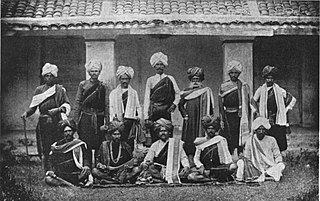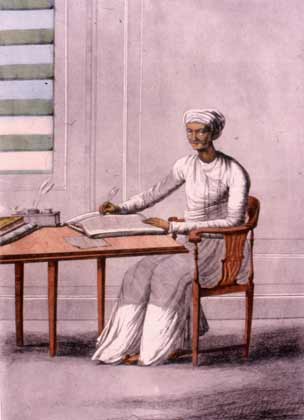Rajput, also called Thakur, is a large multi-component cluster of castes, kin bodies, and local groups, sharing social status and ideology of genealogical descent originating from the Indian subcontinent. The term Rajput covers various patrilineal clans historically associated with warriorhood: several clans claim Rajput status, although not all claims are universally accepted. According to modern scholars, almost all Rajput clans originated from peasant or pastoral communities.
The Bunt people are an Indian community who historically have inhabited the Tulu Nadu region in South India. Bunts were traditionally a warrior-class or martial caste community, with agrarian origins, forming the landed gentry of the region. They are the dominant land-owning, farming and banking community of Tulu Nadu and speak Tulu and Kundagannada as their mother tongue. Today, the Bunts are a largely urbanised community, with a population size of less than one million worldwide.
The Dhangars are caste of people found in the Indian states of Maharashtra, Karnataka, Goa, Madhya Pradesh. They are referred to as dhangar in southern Maharashtra, Goa and northern Karnataka, Golla in Andhra Pradesh and Kuruba in Karnataka and Gavli Dhangars in northern Maharashtra. Some Gavlis live in forested hill tracts of India's Western Ghats. Gavli, also known as Dange or Mhaske, and ahir are a sub-caste of Dhangar. However, there are many distinct Gavli castes in Maharashtra and Dhangar Gavli is one of them.
The Maratha Clan System refers to the 96 Maratha clans. The clans together form the Maratha caste of India. These Marathas primarily reside in the Indian state of Maharashtra, with smaller regional populations in other states.
Rajput is a large multi-component cluster of castes, kin bodies, and local groups, sharing social status and ideology of genealogical descent originating from the Indian subcontinent. The term Rajput covers various patrilineal clans historically associated with warriorhood: several clans claim Rajput status, although not all claims are universally accepted. According to modern scholars, almost all Rajputs clans originated from peasant or pastoral communities.

Vokkaliga is a community of closely related castes, from the Indian states of Karnataka and Tamil Nadu.

Shri Dharmaraya Swamy Temple is one of the oldest and most famous Hindu temples of the city of Bangalore, in Karnataka, India.
Yadavs, also called Jadams, or Jadavs, are a grouping of traditionally non-elite, peasant-pastoral communities or castes in India that since the 19th and 20th centuries have claimed descent from the legendary king Yadu as a part of a movement of social and political resurgence. The term Yadav now covers many traditional peasant-pastoral castes such as Ahirs of the Hindi belt and the Gavli of Maharashtra.

The Kunchitigas are a community of people from Karnataka, India. They are mostly concentrated in the Tumkur, Bangalore, Mysore, Ramanagara, Shivamogga and Chitradurga districts. They are also found in Tamil Nadu.
Kharwar is a community found in the Indian states of Uttar Pradesh, Bihar, Jharkhand, Chhattisgarh, Orissa and West Bengal.
Gavli is a Hindu caste in the Indian states of Maharashtra and Madhya Pradesh. They are a part of the Yadav community.
The Pahadi people are an indigenous group of the Himalayas. Most Indo-Aryan Paharis, however, identify as members of constituent subgroups and castes within the larger Pahari community such as Brahmin, Kshatriya and Dalits.

The Rajbanshi, also Rajbongshi and Koch-Rajbongshi, are peoples from Lower Assam, North Bengal, eastern Bihar, Terai region of eastern Nepal, Rangpur division of North Bangladesh and Bhutan who have in the past sought an association with the Koch dynasty. Koch-Rajbanshi people speak Kamatapuri, belong to Indo-Aryan languages likely due to language shift, and in the past they might have spoken Tibeto-Burman languages. The community is categorised as OBC in Assam and Bihar, and SC in West Bengal. In Nepal they are considered part of the Plains Janjati. In Bangladesh the community is classified as Plains ethnic group under 'Barman'. They are the largest Scheduled Caste community of West Bengal.

The Koli is an agriculturist caste of India. Koli is an Agriculturist caste mostly found in Gujarat. At the beginning of 20th century, the Koli caste was recognised as a criminal tribe under Criminal Tribes Act by British Indian government because of their anti-social activities but during the World War I, Kolis were recognised as a Martial caste by British Indian Empire. Kolis of Gujarat were well-known pirates of Arabian Sea.

Hinduism is the most followed Religion in India and nearly 84% of the total population of Karnataka follows Hinduism, as per 2011 Census of India. Several great empires and dynasties have ruled over Karnataka and many of them have contributed richly to the growth of Hinduism, its temple culture and social development. These developments have reinforced the "Householder tradition", which is of disciplined domesticity, though the saints who propagated Hinduism in the state and in the country were themselves ascetics. The Bhakti movement, of Hindu origin, is devoted to the worship of Shiva and Vishnu; it had a telling impact on the sociocultural ethos of Karnataka from the 12th century onwards.

Bengali Kayastha is a Bengali Hindu caste originated from the Bengal region of Indian subcontinent, and is one of the main subgroups of the Kayastha community. The historical caste occupation of Kayasthas throughout India has been that of scribes, administrators, ministers and record-keepers; the Kayasthas in Bengal, along with Brahmins and Baidyas, are regarded among the three traditional higher castes that comprise the "upper layer of Hindu society". During the British Raj, the Bhadraloks of Bengal were drawn primarily, but not exclusively, from these three castes, who continue to maintain a collective hegemony in West Bengal.
Sadar Lingayats, sometimes also spelled as Sadhu Lingayats, are sub-caste of Veerashaiva community that inhabit Central Karnataka region of the Karnataka state in India. The land-owning feudal community vows its allegiance to Taralabalu Jagadguru Brihanmath, Sirigere. It is one of the dominant sub-castes of the Lingayat community. Gowda, Patel, Patil and Banakar are some of the prominent surnames used by the community.
The Lingayat Vani community is an Indo-Aryan ethnolinguistic group who are native to Maharashtra (Mahratta) in western India. They belong to Veershaiv sect of Hindu Shaivism and are also referred to as Veershaiv-Lingayat Vanik or Lingayat Balija or Vira Banajiga or Bir Vanigas. The name Vani is derived from the Sanskrit word 'Vanijya' which means trade.






